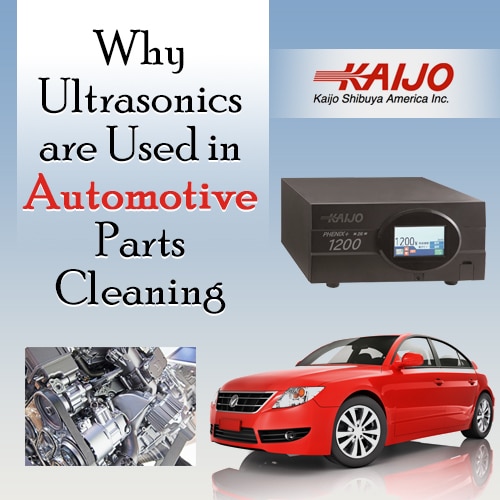Why Ultrasonics Are Used in Automotive Parts Cleaning
March 25, 2020
 Automotive parts are often subject to heavy, hard-to-remove contamination with oil, grease and carbon deposits. Traditional cleaning methods include removing some deposits manually and soaking, spraying, brushing and scraping the parts. These cleaning methods are time-consuming, require a heavy use of chemicals and water and can damage part surfaces. Ultrasonic cleaning of automotive parts is quicker and delivers better cleaning performance while using less water and no chemicals except for mild solvents. Ultrasonic cleaning systems configured correctly for the specific use can save time and money, and effectively clean parts with no damage.
Automotive parts are often subject to heavy, hard-to-remove contamination with oil, grease and carbon deposits. Traditional cleaning methods include removing some deposits manually and soaking, spraying, brushing and scraping the parts. These cleaning methods are time-consuming, require a heavy use of chemicals and water and can damage part surfaces. Ultrasonic cleaning of automotive parts is quicker and delivers better cleaning performance while using less water and no chemicals except for mild solvents. Ultrasonic cleaning systems configured correctly for the specific use can save time and money, and effectively clean parts with no damage.
Different Automotive Cleaning Applications Need Different Ultrasonic Frequencies
When sound waves are generated by ultrasonic transducers immersed in the cleaning solution, they produce tiny cavitation bubbles that deliver a scrubbing action on the surfaces of parts to be cleaned. High ultrasonic frequencies produce smaller bubbles that clean gently while low frequencies generate larger bubbles for robust cleaning. The larger bubbles remove even heavy contamination rapidly but they can damage the surfaces of delicate parts. With higher frequencies and smaller bubbles, ultrasonic cleaning action can be made as gentle as required for soft part surfaces.
Many automotive parts, such as those made of steel, have very hard surfaces and can be exposed to the robust cleaning of low ultrasonic frequencies in the 20 kHz range. Other parts, such as those made of aluminum, have slightly softer surfaces and are best cleaned at frequencies in the 40 kHz range to avoid surface pitting. Parts made of soft material such as plastic or parts with a delicate coating or finish may need even higher frequencies. No matter what the automotive cleaning application, an ultrasonic cleaning system can be configured to clean more effectively than traditional methods.
Ultrasonic Cleaning Power Can Be Increased With Additional Features
For basic ultrasonic cleaning, an ultrasonic generator powers ultrasonic transducers that are immersed in water in a cleaning tank. The parts to be cleaned are placed in the tank and the bubbles produced by the ultrasonic system dislodge dirt on the part surfaces. Sometimes the deposits on the parts contain hardened grease and oil or they are baked-on deposits that are hard to remove. In such cases ultrasonic cleaning can be enhanced by heating the cleaning solution and by adding a mild detergent or solvent to the water.
When tanks with heating are used, the extra heat softens the oil and grease and makes them easier to remove. General-purpose detergents can also help remove such deposits by dissolving some of the contaminants. For especially difficult cleaning applications, solvents designed to attack a specific contaminant are effective in reducing the time required for cleaning. For challenging automotive cleaning applications, ultrasonic cleaning systems using heated solvent baths are a powerful cleaning method delivering excellent results.
Kaijo Can Help With Ultrasonic System Configuration and Equipment
Kaijo’s extensive experience in the ultrasonic cleaning field allows the company to advise customers on the frequencies best suited to their application and how to implement cleaning solution heating and the use of detergents or solvents. Kaijo offers free consultation and can supply ultrasonic cleaning systems ranging from turnkey to separate pieces of equipment suitable for integrating into an existing production line. In addition, Kaijo can also provide customized equipment to meet unique cleaning requirements customers may have.
For the automotive industry, Kaijo can supply ultrasonic cleaning systems operating at frequencies in the 20 kHz range for heavy duty cleaning and at up to 2 MHz for delicate parts such as sensors or electronics. Kaijo’s systems can withstand heating up to 70 degrees centigrade and they are suitable for use with mild detergents and solvents. For any automotive parts cleaning application, Kaijo can propose system characteristics that will deliver the best results and follow up with equipment that will best meet the needs of the customer.





